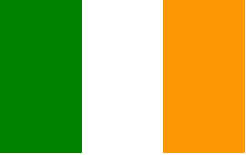
22 - 29 April 1999
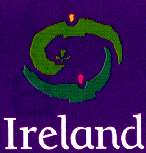
Thursday 22 April 1999
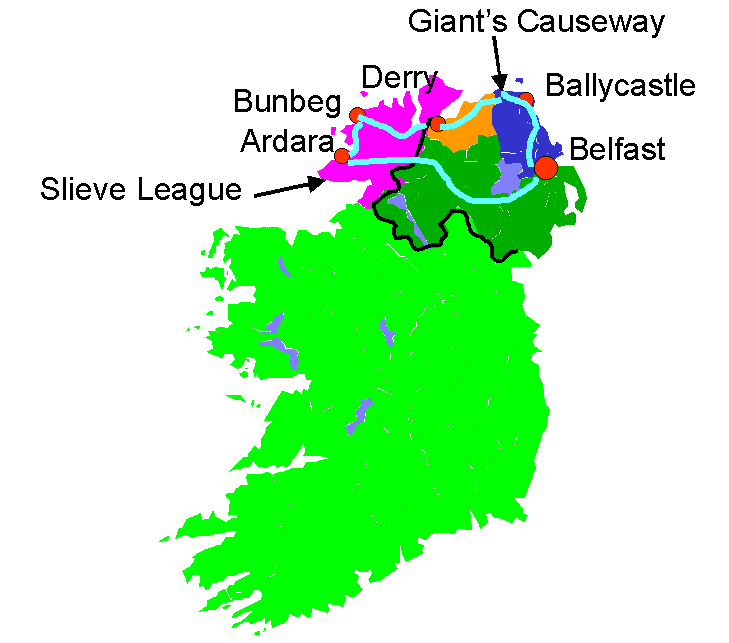 We've
saved enough Airmiles again for a nice trip. This time we are heading for
Ireland for a week. We fly at 9:40am with KLM UK to Belfast.
The flight is slightly delayed,
We've
saved enough Airmiles again for a nice trip. This time we are heading for
Ireland for a week. We fly at 9:40am with KLM UK to Belfast.
The flight is slightly delayed,
but around 11am we're standing in front of the
Alamo desk at Belfast International Airport to collect our rental car. I've
booked the car through Internet, but the price quoted by Alamo on the website
and by e-mail is, according to the sales assistant, exclusive of insurance, a
difference of £70! As the text on the website and on the e-mail does not
mention that anywhere, I insist on the quoted price. After some heated
discussion and frantic calls with head office we get the car for the quoted
price. It's an upgrade too: Vauxhall Vectra 1.8 16v. Around half past eleven
we're driving towards Ballycastle on the North coast of
(Northern) Ireland. We take a bit of a detour through the Glens of County
Antrim, a beautiful drive. In
Ballycastle we take a room with sea view in the Marine Hotel After a simple pub
lunch we drive to the number one attraction of the Antrim Coast: the Giant's
Causeway. The coast line near Bushmills consists of some 37,000 basalt
columns, most of them hexagonal. It is the result of a massive subterranean
explosion some 60 million years ago. The phenomenon stretches all the way to the
Scottish coast on the other side of the Irish Sea. According to legend the giant
Finn McCool fell in love with a female giant from Scotland. He built the
Causeway to enable her to come over to Ireland. After a good walk along the
clifftops looking out over the Causeway and over the Causeway itself we drive on
to the ruins of Dunluce Castle. Once the castle was the home
base of the McDonnell clan who controlled the area. The castle lies on the edge
of the cliffs. This position was also the cause of its decline, because in 1639
part of the castle disappeared in the sea during a storm. Shortly after that
event the family moved away from the coast. The ruins are a great sight on the
edge of the cliffs. After this excursion we drive back to Ballycastle. We take a
swim in the indoor pool of the Hotel.
At night we eat in the simple Kimark restaurant and we drink a pint in one of the many pubs of Ballycastle - McCarroll's.
Friday 23 April 1999
After breakfast we drive to Downhill Castle
in County Derry. This, too, is a ruin. This time of a country
home of the Anglican Bishop of Derry, Frederick Hervey. The House and adjoining
chapel (Mussenden Temple) were built around 1780. Especially Mussenden
Temple lies very beautiful on a hill top overlooking the coast. We
carry on along the coast to Derry (Londonderry). Having arrived
there we take a room in Clarence House, a guest house just outside the city
centre. The room is allright, but the owner is a
bit out of the ordinary. Not
unpleasant, just a bit neurotic.
Derry has earned a dubious reputation during the "Troubles", with an absolute low on Bloody Sunday in 1972. The progress in the peace process has taken away much of Derry's grim outlook. Only the heavy security measures around police stations remind of the tense situation in the recent past. Many check points seem deserted. Derry's main attraction is its old town with a city wall that's completely in tact. We make a marvellous walk over the city walls. From the walls you have a beautiful view of the old city and the areas around. We pass St Collumb's Cathedral (Church of Ireland; protestant) from 1633. In the church there are many memorabilia of military expeditions and a 18th century bishop's throne. The wall also offers a view of the Bogside, the catholic working class area of Derry. From the wall you can still see a number of political murals, among them the famous Free Derry Mural.
Early evening we get the first bit of serious rain. We have dinner in a modern pizza restaurant and go see a movie later (A civil Action with John Travolta). We end the day with a pint in a crowded pub (The Strand).
Saturday 24 April 1999
After breakfast we cross the border into the Republic of
Ireland. You don't notice the border crossing at all. No Check Point, not even a
sign. We're now in County Donegal. Soon after the border we
pass a celtic fort, Grianán of Aileich. It is a round stone fortress without
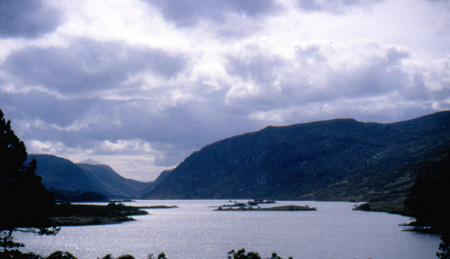 rooms. From its walls we have a fine view of the area. We carry on and have
coffee at Letterkenny, the main city of Donegal. We continue along the northern
edge of Glenveagh National Park to Bunbeg on the West Coast. The roads are
narrow and full of pot holes. You hardly see anyone and there are no villages
whatsoever in this desolate landscape, where you meet the occasional sheep. The
weather becomes brighther and even the sun makes an appearance. Around 1pm we
arrive in Bunbeg and move into Bunbeg House, a good Guest House. After a simple
lunch we set out for Errigal Mountain, one of the highest mountain tops around
here. We attempt to climb it, but the steep path up there is still very boggy
and slippery, which makes the climb difficult and hazardous. When we're past
halfway up we decide to give it up. But already at this level the views are
tremendous. We drive into the Glenveagh National Park and call
on the visitors centre. From here shuttle busses leave for Glenveagh
Castle. The castle is beautifully set on a promontory on the shore of
the Glenveagh lake (or Lough). It was built in 1870 for George Adair. You can
make nice walks along the shores of the lake. At the end of the afternoon we
head back for Bunbeg via small and
rooms. From its walls we have a fine view of the area. We carry on and have
coffee at Letterkenny, the main city of Donegal. We continue along the northern
edge of Glenveagh National Park to Bunbeg on the West Coast. The roads are
narrow and full of pot holes. You hardly see anyone and there are no villages
whatsoever in this desolate landscape, where you meet the occasional sheep. The
weather becomes brighther and even the sun makes an appearance. Around 1pm we
arrive in Bunbeg and move into Bunbeg House, a good Guest House. After a simple
lunch we set out for Errigal Mountain, one of the highest mountain tops around
here. We attempt to climb it, but the steep path up there is still very boggy
and slippery, which makes the climb difficult and hazardous. When we're past
halfway up we decide to give it up. But already at this level the views are
tremendous. We drive into the Glenveagh National Park and call
on the visitors centre. From here shuttle busses leave for Glenveagh
Castle. The castle is beautifully set on a promontory on the shore of
the Glenveagh lake (or Lough). It was built in 1870 for George Adair. You can
make nice walks along the shores of the lake. At the end of the afternoon we
head back for Bunbeg via small and
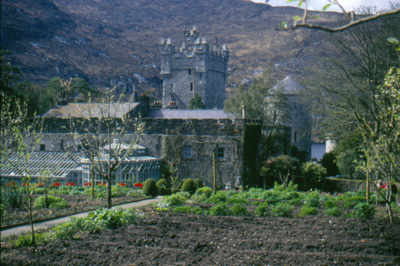 endless roads through a scenery only filled
with a few remote farm houses, many sheep and an occasional peat cutter. Peat is
still being cut here and used as fuel for the fire place. In the villages you
can always smell the burning peat. Finding our way back is not easy. The road
signs are few and far between and and the place names are sometimes in English,
but also often just in Gaelic and our road map does not have Gaelic names for
each village or town.!
endless roads through a scenery only filled
with a few remote farm houses, many sheep and an occasional peat cutter. Peat is
still being cut here and used as fuel for the fire place. In the villages you
can always smell the burning peat. Finding our way back is not easy. The road
signs are few and far between and and the place names are sometimes in English,
but also often just in Gaelic and our road map does not have Gaelic names for
each village or town.!
At night we have dinner in the Sea View hotel. The food is OK, but a bit expensive for the quality offered. After that we drive to the next village, Crolly, where we find Leo's Tavern. The owners, Leo en Baba Brennan were at some point in time famous Irish dance band musicians, but their children rose to greater fame. Three of them are members of the group Clannad and a fourth is the singer Enya. It is very obvious that Leo is very proud of his offspring. The walls are covered with posters and golden CD's . It is a cosy pub (some Gaelic is spoken) and late at night there is live music and the celebration of a wedding anniversary of a local couple.
Sunday 25 April 1999
The day starts out grey. There's a strong wind. We drive
through the Bloody Foreland, North of Bunbeg. It is a rough and
forbidding
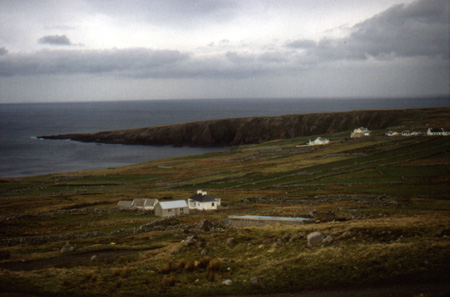 landscape, that allows very little vegetation. Housings sticks to the
shoreline. At Magheroarty we defy the drizzle and make a long walk on the
deserted beach. After that we return to Bunbeg. We have a (fast food) lunch and
make a drive through the Rosses. This too is scarcely populated
coastal area. We end up in Dungloe, the only town of significance around here.
It's a Sunday and all shops are closed. We have a drink in the Tírconnail pub.
At the back of the pub there is a huge window, with a view of the magnificent
coast line. Very special. The pub closes at two in the afternoon and we are on
our way again. This time to Dunlewy, where there is a Craft Centre on the shore
of the lake. You can buy craftwork and see it being made. You can also make a
boat trip on the lake. We don't do that and return to the Guest House, which we
find abandoned. The owners, Andrew and Jean are gone, without a trace.
landscape, that allows very little vegetation. Housings sticks to the
shoreline. At Magheroarty we defy the drizzle and make a long walk on the
deserted beach. After that we return to Bunbeg. We have a (fast food) lunch and
make a drive through the Rosses. This too is scarcely populated
coastal area. We end up in Dungloe, the only town of significance around here.
It's a Sunday and all shops are closed. We have a drink in the Tírconnail pub.
At the back of the pub there is a huge window, with a view of the magnificent
coast line. Very special. The pub closes at two in the afternoon and we are on
our way again. This time to Dunlewy, where there is a Craft Centre on the shore
of the lake. You can buy craftwork and see it being made. You can also make a
boat trip on the lake. We don't do that and return to the Guest House, which we
find abandoned. The owners, Andrew and Jean are gone, without a trace.
At night we have dinner at the Ostan Gweedore hotel. The building is ugly, but it is beautifully located on top of a hill overlooking the coast. From our table we have a marvellous view of the beach, the bay and the sunset. The food is fine, but again a bit expensive. We regularly see cars driving in circles on the beach, apparently out of sheer boredom, as there is not a lot of entertainment around. After dinner we drive to Crolly again to Leo's Tavern. Tonight is fairly quiet and unfortunately without live music. On return in Bunbeg our landlords have resurfaced and we get a change of towels.
Monday 26 April 1999
Today promises to be a fine and sunny one. The sky is
blue,
the sun's out and there is not a cloud in sight. What a difference with
yesterday.
We are headed for Ardara, some 80km (50m) south. We take a room
in the Nesbitt Arms Hotel, that has just been renovated. We then drive through
the pretty Glengesh pass to Glencolumbcille,
on the coast. We have lunch in a little café and have a look at the Folk
Village. This is a collection of rebuilt cottages, in which you can see how
people lived around here in the 18th and 19th century. Judging from what we see
and from the story the guide is telling us we get the impression that life must
have been pretty primitive right until the 1950's. It was only then that the
area was connected to the electric power network. The coast is rugged and
beautiful. But we move on to Slieve League. What we find here
is undescribable. After a drive on narrow and winding roads we get a look at the
highest cliffs in Europe. The cliffs rise no less than 600 metres (2,000ft)
above the sea. From the point were the road ends you can walk further up the
cliffs. But in spring the
ground is still boggy and slippery and after climbing a few hundred metres we
stop. But the view is still
magnificent! The weather has meanwhile become even
better. The sun is still shining and the temperature has risen to 18 degrees
Celsius (65 F). We descend again and follow the coast to the fishing town of
Killybegs. We have a drink here and stroll along the quays where everything is
connected to the fishing industry. We drive on to John's Point. This is an
ithmus near Killybegs. From the tip of it we have a fine view of Killybegs' Bay.
It has already become five o' clock and it's time to get back to the hotel. We have dinner in the hotel. Ardara is a very small town, famous for its weaving and knitware, but it has a impressive number of pubs. On a Monday night, however, most of them are conspicuously empty. We have a drink in the Corner Bar.
Tuesday 27 April 1999
The weather looks bright once more. Lots of sunshine. We
decide to go walking. From Ardara there are many options. There are six
signposted walks varying in length from 4 to 16km (2.5 to 10 miles). We decide
to do two shorter ones. The first takes us through boggy turf fields, towards
the Owenea river. A fine walk through the quiet fields, with lots of sheep and a
fast running river (lots of fish). The second walk
takes us to Long Point along a bay that falls dry at low tide. In the afternoon
we drive to Maghera and pass the Assarancagh waterfall. We follow a narrow
coastal road with the narrow Loughros Beg bay on the one hand and steep mountain
slopes on the other. At the hamlet of Maghera we head for the beach. Although
the weather is superb, a dive in the water would be overdoing things. We carry
on along unsealed roads, seemingly leading nowhere, but just when we start
thinking that we're lost we get back to the civilised world and find our way
back to Ardara.
At night we have dinner in the hotel again and have a drink in Nancy's pub. A tiny convivial pub, that has been in the hands of the same family for six generations, we are told.
Wednesday 28 April 1999
Today we drive to Belfast. A reasonably long drive of about 200km (125m). Around 1am we arive at Dukes Hotel. We chose this hotel because most of other goodish hotels were booked up. The room rate of £110 sounds promising, but we're a bit disappointed. The room is spacious, but not out of the ordinary. The facilities are ok, but still...
The hotel is close to the university which makes the area
very lively. On Botanic Avenue
there are lots of bars, cafe's and nice restaurants with side walk cafe's. The
weather is again very good (20 degrees) and we sit down for an outdoor lunch at
the Café Vincent on Botanic Avenue. After that we walk to the city centre. In
the gardens in front of the City Hall is abuzz with young
people enjoying the sun. The city hall is a dominating building on Donegall
Square. It was built in 1906 in a collection of styles from all corners of the
empire. In front of the building stands an impressive statue of Queen Victoria.
The Commercial District (shopping) is very lively.
We end up in the gardens of
City Hall enjoying the sun and the crowds passing by. Later we make for the Crown
Liquor Saloon, opposite Opera House. It is a pub in a beautiful
Victorian building. Tiled façade. Stained glas windows. Inside there is a
central space with standing room and along the wall we find a number of oak
panelled compartments (snugs) with table and benches in it. You can even close
them with a door. Inside the snugs the decorations are pretty too.
At night we have dinner at an Indian restaurant on Botanic Avenue. After that we go looking for the Rotterdam Bar. It turns out to be located well out off the centre in the docklands. After a long walk and asking for directions a few times we finally get there. The area is under development. The bar is wedged between derilict warehouses and newly built apartment blocks. Unfortunately we chose the wrong night. Tuesdays and Sundays are for live music. Tonight it is (too) quiet. That's why we decide to move on and explore Belfast's modest gay nightlife. There are two bars, but Wednesday night does not seem the best nigth out.
Thursday 28 April 1999
This is already the final day of our holiday. After a good
breakfast we have coffee at Madission's, a large modern café on Botanic Avenue.
We have a walk through the Botanic Gardens of the university.
An oasis of peace and quiet in the busy neighbourhood. In the gardens there is
the Palm House, a hot house with lots of tropical plants and trees. Further on
in
the garden is the Ulster Museum. But because of the beautiful weather we decide
to enjoy outdoor life and take a stroll along the banks of the Lagan River out
of town. Around noon we return to the university area. Also along Stranmill Road
there are lots of cafés and other student hot spots. The streets are abuzz ,
especiall with students. We have lunch at Madisson's and around half past one we
head for the airport. It is the end of our holiday.